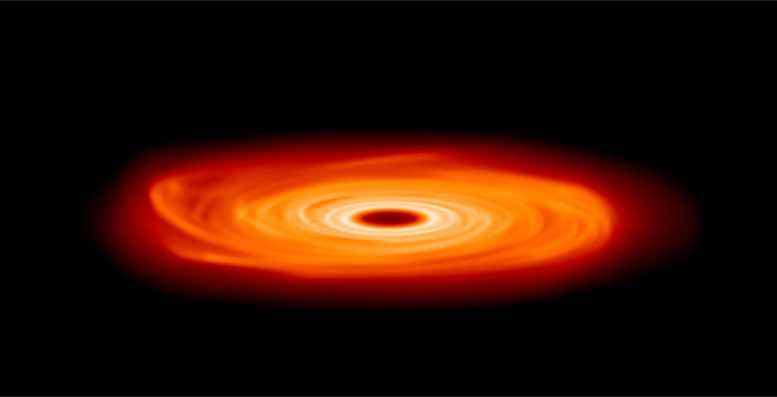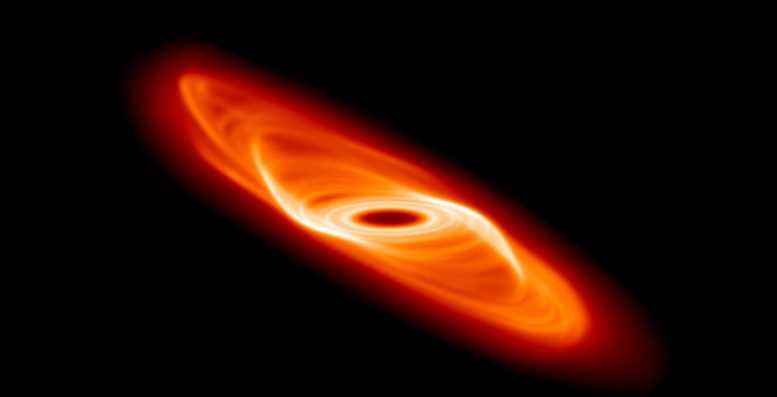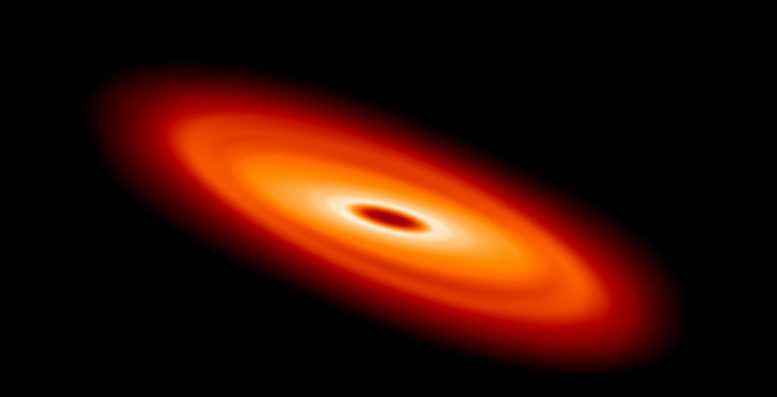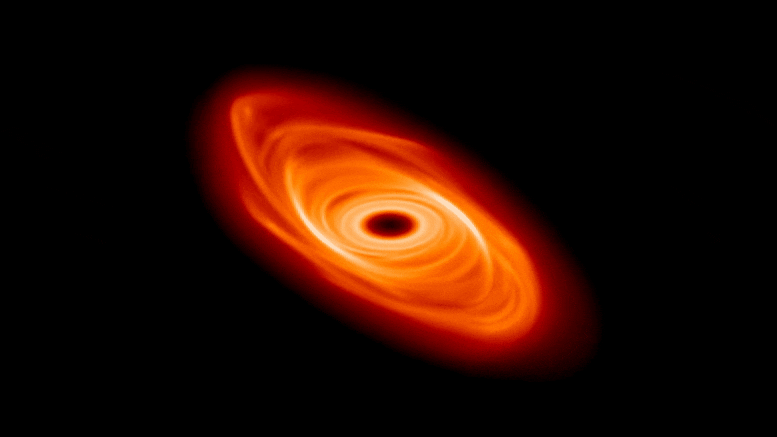Bir ön-gezegensel diskin sarmal yapısını yok eden bir çözgünün etkisi. Kredi: Warwick Üniversitesi
dan yeni bir çalışma[{” attribute=””>University of Warwick demonstrates the impact of passing stars, misaligned binary stars, and passing gas clouds on the formation of planets in early star systems.
- University of Warwick scientists identify a process that hinders the formation of planets through Gravitational Instability in the early evolution of solar systems
- Protoplanetary discs have been observed by astronomers with warps curving their surface
- Modeling from the Warwick team demonstrates that these warps can wipe out the spiral structure that allows planets to form via Gravitational Instability

Image showing a rotating protoplanetary disc without a warp. Credit: University of Warwick
A new study from the University of Warwick demonstrates the impact of passing stars, misaligned binary stars, and passing gas clouds on the formation of planets in early star systems.
Scientists have modeled how cosmic events like these can warp protoplanetary discs, the birthplaces of planets, in the early evolution of solar systems. Their results were published on February 3, 2022, in the Astrophysical Journal in a study funded by The Royal Society and the Engineering and Physical Sciences Research Council, part of UK Research and Innovation.
Solar systems are formed from protoplanetary discs, massive spinning clouds of gas and dust that will eventually coalesce into the array of planets that we see in the Universe. When these discs are young they form spiral structures, with all their dust and material dragged into dense arms by the massive gravitational effect of the disc spinning.

Image showing a rotating protoplanetary disc with a warp in its initial stages. Credit: University of Warwick
But astronomers have found a surprising number of protoplanetary discs that, despite being massive enough to have a spiral structure, show no evidence of one. The University of Warwick team have been investigating what might prevent a disc from forming a spiral structure.
PhD student Sahl Rowther from the University’s Department of Physics created a three-dimensional hydrodynamical simulation of a normal, flat self-gravitating disc using a technique called smoothed-particle hydrodynamics. To this, he added different levels of curvature to the disc to warp it, to study the impact on the disc’s spiral structure. In all but the smallest warps, the spiral structure disappeared.

Image showing a rotating protoplanetary disc with a warp in later stages. Credit: University of Warwick
The spiral structure in a protoplanetary disc is vital for the formation of planets through Gravitational Instability and the results improve our understanding of how solar systems evolve.
Co-author Dr. Rebecca Nealon, Stephen Hawking Fellow in the Department of Physics, said: “Warps will inhibit planet formation through Gravitational Instability, in the sense that these spiral structures, which fragment into clumps that eventually form planets, are where the disc structure will be disrupted. Anything that disturbs that spiral structure makes it harder for that clumping to occur and harder for the planets to form via Gravitational Instability.”
The scientists explain that the warp heats up the disc by inducing small perturbations to the velocity of the gas as it orbits. The gas needs to be cool in order to clump together, so in heating up the disc the spiral arm structure is wiped out.
There are a number of ways that a protoplanetary disc can be warped. A few examples include; if a large object, such as a star, passes nearby in a flyby encounter; if the disc surrounds a binary star system that orbits out of alignment with the disc; or if a nearby source of gas accretes onto the disc.
Bir ön-gezegensel diskin sarmal yapısını yok eden bir çözgünün etkisini gösteren video. Kredi: Warwick Üniversitesi
Son yıllarda, çarpık ilk-gezegen diskinin kanıtları önemli ölçüde arttı ve bu, bunların Evrende önceden düşünülenden daha yaygın olduğunu düşündürüyor. Aynı zamanda, sarmal bir yapı göstermeyen çok sayıda büyük gezegen öncesi diskler için potansiyel bir açıklama sağlar.
Dr. Nealon şunları ekliyor: “Normalde bu disklerin ayrı ayrı oluştuğunu düşünüyoruz, ancak durum gerçekten böyle değil. Yakınlarda çok sayıda yıldızın bulunduğu kaotik bir mahalle ve yakınlardan geçen bir yıldızınız olabilir ve bu yerçekimi etkileşimi bu çarpıklığa neden olmak için yeterlidir.
“Bir kez çarpık disklerin gözlemlerini almaya başladığımızda, modellememizde çarpıklıkları dikkate almaya başlamamız gerekiyordu. Ön-gezegensel disk evrimindeki çarpıklıkları daha fazla dikkate almamız ve çarpıkların mevcut disk evrim mekanizmalarını ve fiziğini etkileyebileceğini anlamamız gerekiyor. Çarpıkların gezegen oluşumundaki tüm faktörleri nasıl etkilediğini düşünmemiz gerekiyor.”
Sahl Rowther şunları söyledi: “Bu çalışma, daha önce birleştirilmemiş olan iki fiziksel etkiyi, kendi kendine yerçekimi olan disklerin fiziği ile çarpıklığı birleştiriyor. Bu önemlidir çünkü kendi kendine yerçekimi olan diskler bir süredir çalışılmaktadır ve bu iyi kurulmuş bir alandır. Çözgüler çok daha yeni bir fikir.
“Yaptıklarımızdan gerçekten emin olmamızı sağlamak ve bunu kolayca göstermek için bunu mümkün olan en basit şekilde modelledik.”
Referans: Sahl Rowther, Rebecca Nealon ve Farzana Meru, 3 Şubat 2022, Astrofizik Dergisi.
DOI: 10.3847/1538-4357/ac3975

